Home brewers, your secret weapon for brewing a memorable pint lies in understanding and mastering the use of hops in beer. These small yet powerful flowers are more than just a brewing ingredient. They are the architects that build a beer’s character by balancing bitterness, infusing intriguing flavors, and promoting longevity.
Our detailed guide is your roadmap to the universe of hops. We’ll traverse different varieties, explore their distinctive characteristics, and uncover their vital role in your homebrewed creations. You’ll learn the science behind their contributions, the nuances of timing hop additions, and the art of selecting the right hop for your brewing endeavor. We’ll even preview what’s on the horizon in hop research and development.
Whether you’re a brewing novice or an experienced brewmaster, prepare to elevate your home brewing journey with a newfound respect and understanding of hops. Let’s dive in and turn your home brews into hop-infused masterpieces!
Introduction to Hops in Brewing – Aroma, Bittering and Preservation
Overview of Hops as a Brewing Ingredient
What are hops and where do they come from?
Hops are the cone-shaped flowers that grow on climbing vines called bines. Though originally native to Europe, Asia, and North America, these days they’re cultivated in many regions worldwide.
Interestingly, hops belong to the same family as cannabis, but rest assured, they don’t contain any psychoactive compounds.
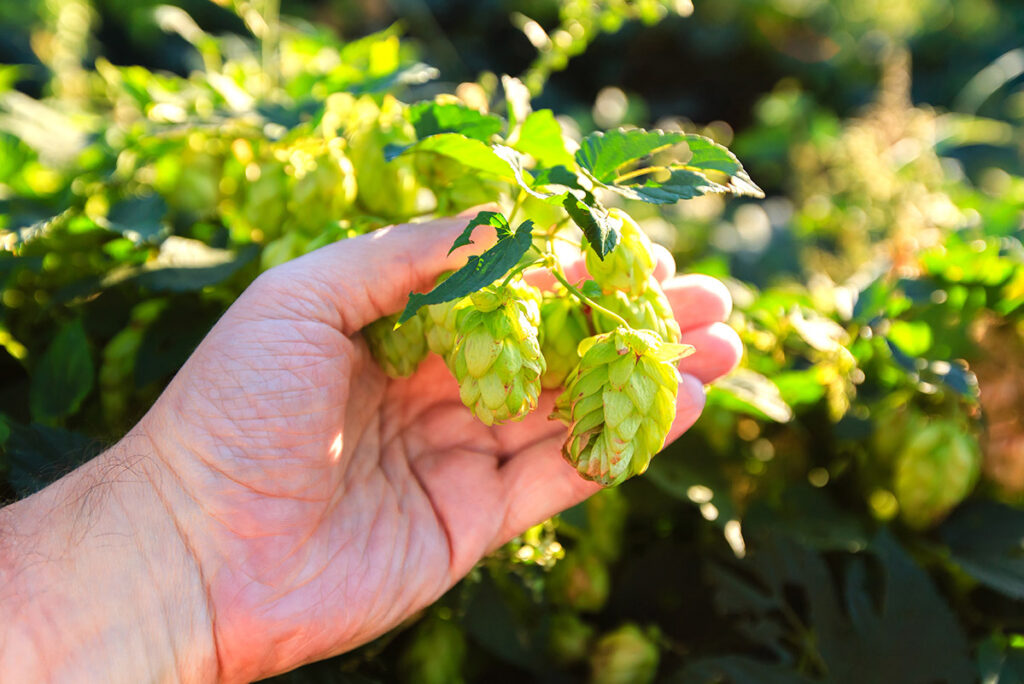
How are hops harvested and processed for brewing?
Harvesting hops takes place in late summer or early autumn when the cones are ripe and fragrant. The hops are then carefully removed from the bines and dried in kilns to reduce their moisture content and maintain their quality.
Once dry, they’re processed into various forms for brewing, such as whole cones, pellets, extracts, powders, and more.
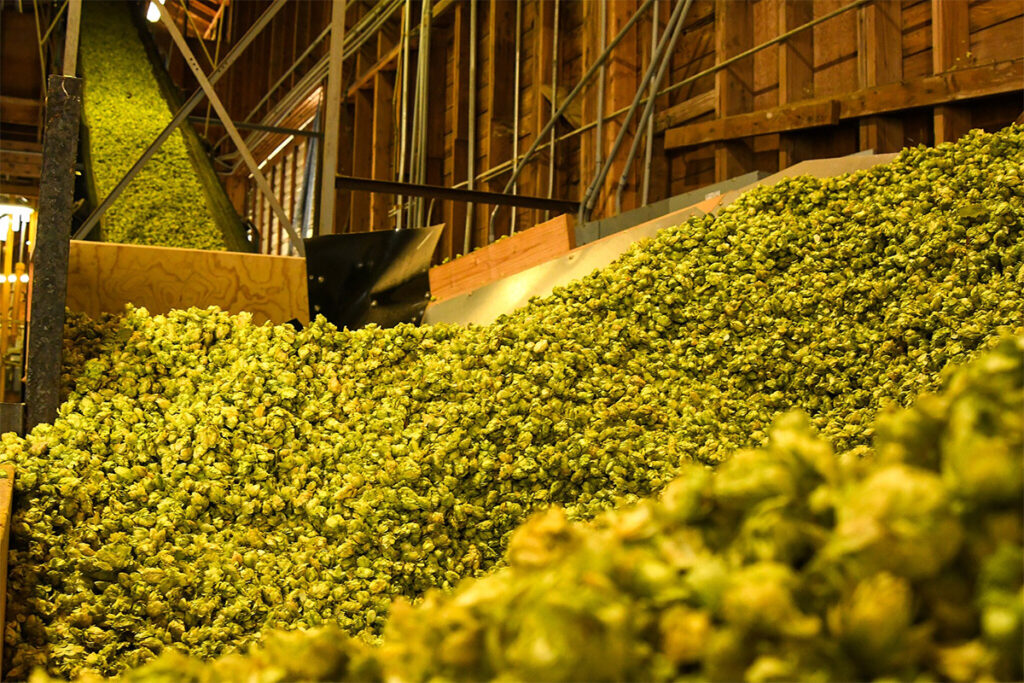
What are the main components of hops that affect beer?
Hops contain several compounds that play a significant role in the bitterness, flavour, aroma, and stability of beer. The most critical compounds are alpha acids, beta acids, and essential oils.
Alpha acids are responsible for beer’s bitterness, while beta acids contribute to hops’ preservative properties, and essential oils provide distinctive aromas and flavours.
We Sell Hops!
Here at the Yeast Platform, we sell the highest quality hop pellets at great prices. Our hops are stored in ideal conditions to keep your homebrew beer tasting great.
Check out our range and get yours now!
Significance of Hops in Beer Flavor, Aroma, and Preservation
How do hops balance the sweetness of malt and add complexity to beer?
Hops are fantastic for counterbalancing malt’s sweetness, as they add a bitter taste that stimulates the palate and enhances the perception of other flavours. They also contribute to beer’s complexity by creating diverse flavour profiles based on the hop variety, amount, and timing of hop additions.
With the right hops, you can produce flavours ranging from citrusy and fruity to herbal and spicy to piney and resinous.
How do hops impart distinctive aromas and flavours to beer?
Essential oils in hops are responsible for giving beer its unique aromas and flavours. These volatile compounds evaporate quickly and stimulate olfactory receptors.
Composed of various terpenes, esters, aldehydes, ketones, and more, essential oils have different aroma descriptors, such as floral, grassy, or earthy. These oils are extracted from hops during various stages of the brewing process, including boiling, whirlpooling, or dry hopping.
How do hops prevent spoilage and extend the shelf life of beer?
Hops are like little superheroes, preventing spoilage and extending beer’s shelf life by acting as natural preservatives or antioxidants. Hop compounds like alpha acids, beta acids, and polyphenols inhibit bacteria, fungi, or other microorganisms’ growth, which could spoil beer. They also scavenge oxygen radicals that can cause oxidation and stale flavours in beer.
Hops are a vital ingredient in brewing, providing balance, complexity, and preservation to your homemade beer. So, when planning your next homebrewing adventure, remember to choose the right hops to create the perfect blend of flavours and aromas.
Exploring the World of Brewing Hops Varieties

The Main Categories of Hop Varieties
Traditional Hops: The Noble Origins
Traditional hops, often called noble hops, are the foundation of many classic European beer styles.
These hops include:
- Czech Saaz
- Tettnanger
- Spalt
- Hallertau Mittelfruh,
These varieties are renowned for their low alpha acid percentage (around 3-6%) and high essential oil content, particularly humulene. This unique composition gives traditional hops a delicate, floral, spicy, and herbal aroma, making them a favourite among brewers crafting Bohemian Pilsners, Oktoberfest/Marzen, Dunkel, and Wheat/Weizen beers.
To make the most of these hops, they’re generally added at the end of the boil or as a dry hop to impart their distinct aromas.
Aroma Hops: The Modern Craft Beer Staple
Aroma hops have taken centre stage in the world of modern craft beer. With a low to moderate alpha acid percentage (around 3-10%) and an oil profile that lends itself to exceptional aromas, these hops are incredibly versatile.
Some popular examples are:
- Cascade
- Centennial
- Citra
- Mosaic
- Crystal
- Galaxy
- Fuggle
- Nelson Sauvin
- U.S. Goldings
- Willamette
These hops are grown in diverse regions such as the U.S., Australia, England, and New Zealand.
These hops boast a wide range of enticing aromas, from citrus, pine, and tropical fruit to floral, earthy, and spicy notes. Brewers love using aroma hops in contemporary beer styles like American Pale Ale, India Pale Ale, Saison, Belgian Ale, and Sour Ale. To capture their remarkable scents, aroma hops are typically added at the end of the boil or as a dry hop.
Bittering Hops: Balancing the Sweetness
Bittering hops are the unsung heroes that help balance the sweetness of the malt in high gravity beers. With a high alpha acid percentage (around 10-20%) and a low essential oil content, these hops provide a strong and clean bitterness to many beer styles.
Magnum, Chinook, Columbus, Simcoe, Comet, and Zeus are just a few examples of bittering hops, hailing from various regions like the U.S., Germany, and England.
High gravity beers such as Imperial Stout, Barleywine, and Double IPA owe their bold flavours to bittering hops. These hops are usually added at the beginning of the boil to extract their potent bitterness, creating a well-rounded and complex final product.
Understanding Flavours and Aromas of Different Hop Varieties
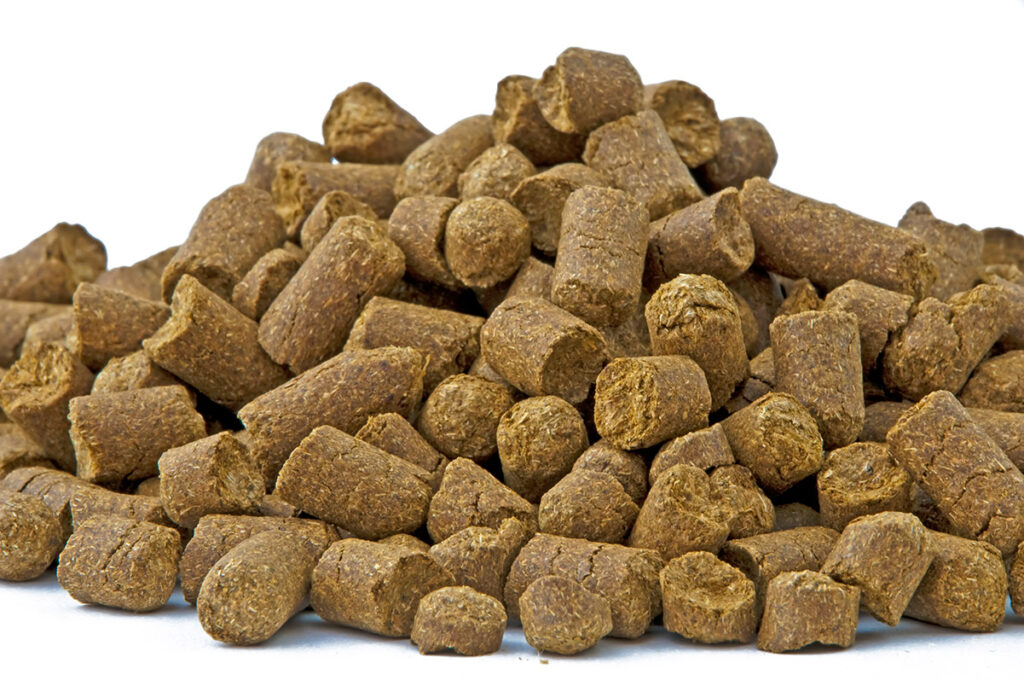
In this section, we’ll delve into the flavours and aromas of various hop varieties, focusing on two key categories: citrusy and fruity hops, and herbal and spicy hops.
By grasping these characteristics, you’ll be able to choose the ideal hops for your next homebrew adventure.
Citrusy and Fruity Hops
Citrusy and fruity hops are renowned for their high essential oil content and low to moderate alpha acid percentage (around 3-10%).
These hops boast a flavour profile that spans zesty citrus fruits like lemon, lime, orange, and grapefruit to tropical sensations such as mango, pineapple, lychee, and passionfruit.
Popular examples of citrusy and fruity hops include:
- Citra
- Mosaic
- Amarillo
- Simcoe
- Cascade
- Centennial
- Galaxy
- Topaz
- Zappa
These hops are cultivated in various regions, such as the U.S., Australia, and New Zealand.
When it comes to brewing, citrusy and fruity hops are perfect for invigorating beers, like American Pale Ales, India Pale Ales, Saisons, Belgian Ales, Sour Ales, and Wheat Beers. To maximise their flavour and aroma, these hops are commonly added at the end of the boil or used as a dry hop.
Herbal and Spicy Hops
In contrast, herbal and spicy hops have a moderate to high essential oil content and a low to high alpha acid percentage (around 3-15%).
Their flavour profile covers herbal notes like mint, sage, thyme, and basil, as well as spicy notes such as pepper, clove, nutmeg, and cinnamon⁴.
Notable examples of herbal and spicy hops are:
- Saaz
- Tettnanger
- Spalt
- Hallertau Mittelfruh
- Fuggle
- Golding
- Willamette
- Mt. Hood
- Sterling
- Pekko
These hops come from various regions, including Germany, the Czech Republic, England, and the U.S.
If you’re aiming to brew complex beers, herbal and spicy hops are an excellent choice. They work well in styles like Bohemian Pilsners, Oktoberfest/Marzens, Dunkels, Weizenbocks, Bocks, Dubbels, Tripels, and Quadrupels. Similar to citrusy and fruity hops, these varieties are typically added at the end of the boil or as a dry hop to impart their unique flavours and aromas.
Piney and Resinous Hops: The Bold Flavours of the Forest
Boasting a high alpha acid percentage (around 10-20%) and a low to moderate essential oil content, piney and resinous hops offer a flavour profile that brings the essence of pine needles, resin, sap, wood, earth, and darkness.
If you’re keen to brew a bold beer, these hops will transport the forest straight to your glass.
Some examples of these hops include:
- Chinook
- Columbus
- Simcoe
- Warrior
- Eureka
- Idaho 7
- Apollo
- Summit
- Zeus
- Comet
Originating from various regions such as the U.S., Germany, and England, there’s a world of options for you to explore.
Ideal for brewing bold beers like Imperial Stouts, Barleywines, Double IPAs, Black IPAs, American Strong Ales, and Red Ales, these hops are typically added at the beginning of the boil to extract their bitterness or as a dry hop to impart their flavour and aroma.
Notable Hop Varieties and Their Unique Properties
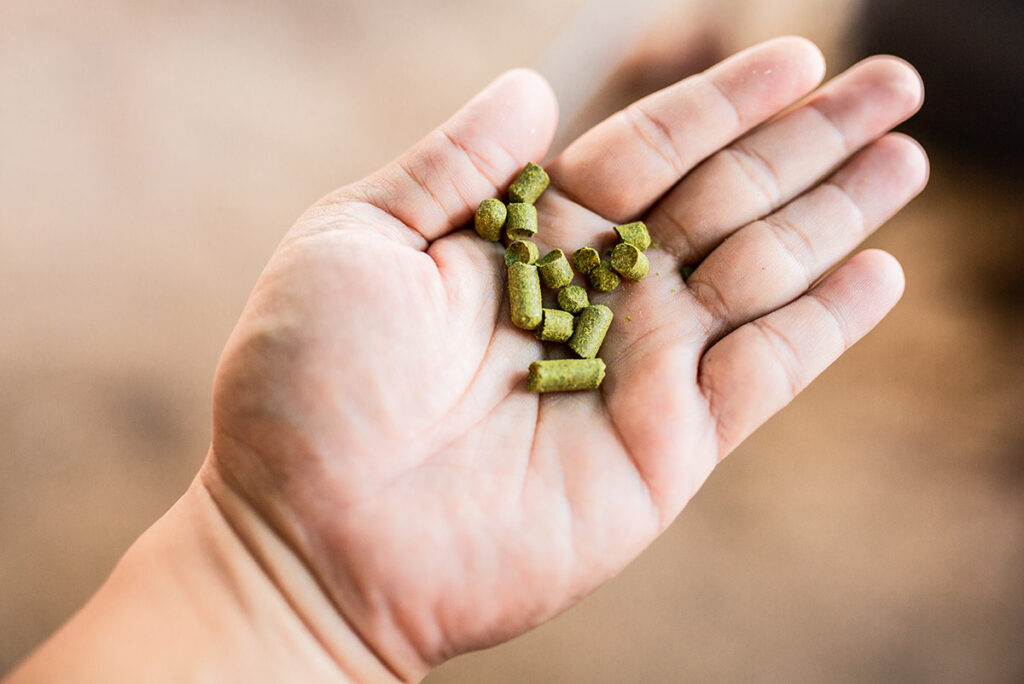
Let’s take a closer look at some of the most popular or interesti2ng hop varieties across the globe and uncover their unique properties.
Citra: The Citrus and Tropical Fruit Sensation
Citra, one of the most sought-after hops for its vibrant citrus and tropical fruit flavours and aromas, was developed by Hop Breeding Company in 2007 and released in 2009.
A cross between Hallertau Mittelfruh and a male hop derived from Cascade, Citra’s exceptional taste and aroma have earned it a place in modern craft beers like Sierra Nevada Torpedo IPA, Three Floyds Zombie Dust, and Trillium Congress Street IPA.
Saaz: The Classic European Hop
Saaz, one of the oldest and most revered hop varieties in Europe, is a classic German noble hop featured in the Reinheitsgebot, or the German Beer Purity Law.
With a low alpha acid percentage (around 3-5%) and a high essential oil content (especially humulene), Saaz delivers a delicate, floral, spicy, and herbal aroma.
This esteemed hop is used in classic European beer styles like Bohemian Pilsner, Oktoberfest/Marzen, Dunkel, and Weizenbock.
Mosaic: The Versatile and Complex Wonder
Mosaic is one of the most versatile and complex hops available, offering a diverse range of flavours and aromas. Developed by Hop Breeding Company in 2012 and released in 2013, Mosaic is a daughter of Simcoe and a Nugget-derived male hop.
With a high alpha acid percentage (around 11-14%) and a moderate essential oil content (especially myrcene), Mosaic delivers flavours and aromas of citrus, pine, tropical fruit, berry, herbal, and earthy notes. Its versatility can be found in modern craft beers like Founders Mosaic Promise, Firestone Walker Luponic Distortion, and Stone Delicious IPA.
The Multi-Faceted Role of Hops in Craft Beer
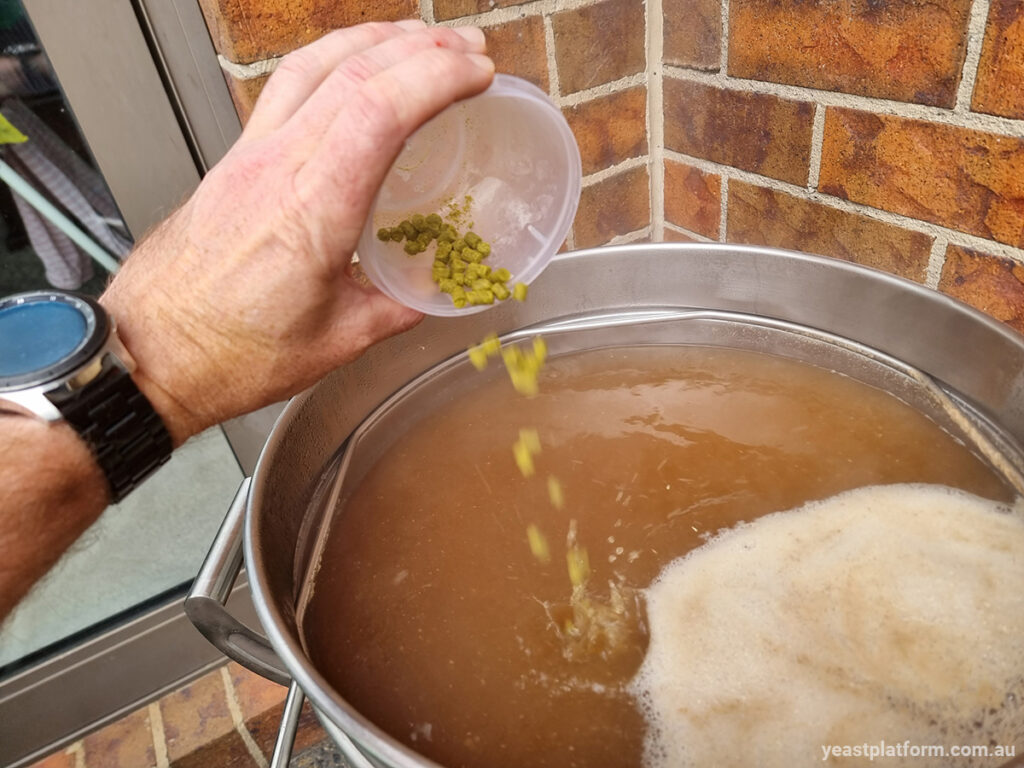
Hops play a vital role in the brewing process, influencing the bitterness, aroma, and overall flavour of your beer. In this section, we’ll dive into the science behind hops and their impact on your homebrew.
How Hops Contribute to Beer Bitterness
To make informed decisions on which hops to use and how much to add to your homebrew, it’s important to understand the science behind hops’ bittering properties.
The Science of Iso-alpha Acids
When boiling your wort, alpha acids are extracted from the hops and undergo a process called isomerisation, forming iso-alpha acids. These iso-alpha acids give beer its bitterness and are measured by International Bitterness Units (IBUs).
Factors like hop variety, boil time, pH, and water chemistry influence your beer’s bitterness level.
For example, increasing the boil time and temperature will produce more iso-alpha acids, while a lower pH and higher sulphate content will enhance the perception of bitterness.
Bittering Hops and Their Impact on Beer
Bittering hops contain high alpha acids (around 10-20%) and low essential oils. They provide a robust, clean bitterness that counterbalances the malt’s sweetness.
To calculate your beer’s IBUs, use this formula:
IBU = (weight of hops in grams) x (% alpha acid) x (utilisation) x (1000) / (volume of wort in litres)
The ideal bittering hops for your beer depend on the style, bitterness level, flavour profile, and balance you’re after.
For instance, try Magnum for Pilsners, Chinook for American Pale Ales, Columbus for India Pale Ales, and Warrior for Imperial Stouts.
How Hops Contribute to Beer Aroma
The aroma of your beer is just as vital as its bitterness. Let’s explore the science behind hop aroma and its impact on your brew.
Volatile Compounds and Their Role in Aroma
Volatile compounds, which evaporate easily and stimulate your olfactory receptors, are responsible for your beer’s aroma. They come from hop essential oils, consisting of complex mixtures of terpenes, terpenoids, alcohols, aldehydes, ketones, esters, and sulfur compounds.
Several factors, such as hop variety, addition time, temperature, and fermentation, can influence the formation and retention of these volatile compounds.
For example, different hop varieties have unique essential oil profiles, while late hop additions or dry hopping can boost extraction and retention of aroma compounds.
Aroma Hops and Their Impact on Beer
Aroma hops have a low to moderate alpha acid percentage (around 3-10%) and a desirable oil profile. They offer a variety of aromas, from citrus and pine to tropical fruit, floral, earthy, and spicy.
The right aroma hops for your beer depend on the desired intensity, quality, and balance.
For example, try Cascade for American Pale Ales, Saaz for Bohemian Pilsners, Citra for India Pale Ales, or Fuggle for English Porters.
With a better understanding of hops’ role in both bitterness and aroma, you’ll be well-equipped to make informed decisions when selecting hops for your homebrew.
How To Use Hops In Beer For Ideal Flavour
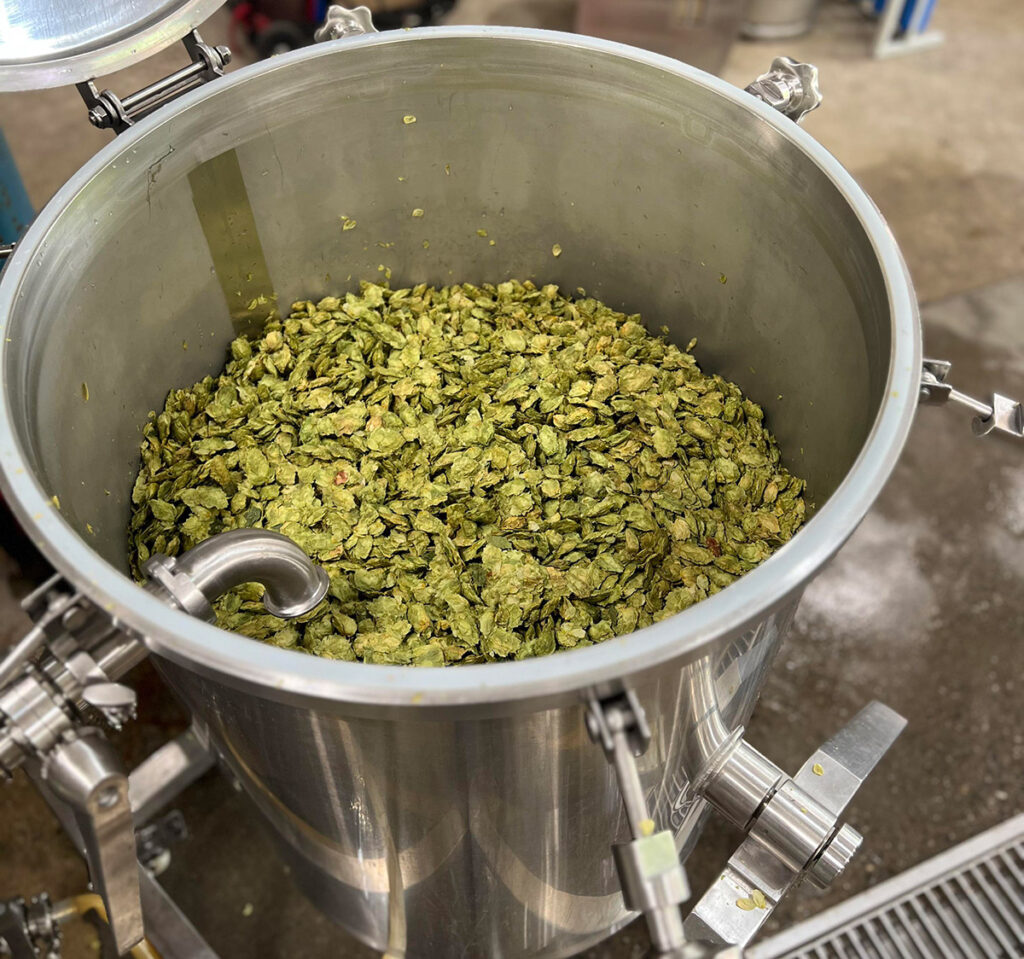
Timing is Everything: The Importance of Hop Additions
As any home brewer knows, the timing of hop additions significantly impacts the final product’s bitterness, flavour, aroma, colour, clarity, and foam stability.
Different hop compounds are extracted or evaporated at varying rates depending on their temperature and exposure to the wort. In this post, we’ll explore the different stages of hop additions and provide tips on when to add hops for specific purposes or effects.
Stages of Hop Additions: A Quick Overview
There are several stages of hop additions during the brewing process, each contributing to different aspects of your beer.
These stages include:
- Mash hopping: adding hops to the mash tun along with the grains
- First wort hopping: adding hops to the boil kettle as the wort is drained from the mash tun
- Boil hopping: adding hops at various times during the boil, usually categorised as bittering, flavour, and aroma additions
- Whirlpool hopping: adding hops after the boil is finished but before the wort is chilled
- Dry hopping: adding hops after the boil or during fermentation
When to Add for Different Effects
To achieve the desired bitterness, flavour, and aroma in your beer, it’s essential to know when to add hops during the brewing process.
Here are some general guidelines:
- For bitterness: add hops at the beginning or early stages of the boil (60-30 minutes) to extract more alpha acids and produce more bitterness
- For flavour: add hops at the middle or late stages of the boil (30-10 minutes) to extract some essential oils and produce some flavour
- For aroma: add hops at the end or after the boil (10-0 minutes) or during fermentation to extract more volatile compounds and produce more aroma
Early Additions for Bitterness: Tips and Tricks
If you’re looking to maximise bitterness in your beer, early hop additions are the way to go.
To optimise these early additions for maximum bitterness efficiency, consider the following tips:
- Use high alpha acid hops to get more bitterness per gram of hops
- Use a hop spider or hop bag to prevent hop material from absorbing wort and reducing yield
- Adjust the pH of the wort to around 5.2 to enhance isomerisation and solubility of alpha acids
Late Additions for Aroma
If you’re looking to enhance the aroma of your homebrew, adding hops during the late stages of the boil is an excellent strategy. This technique allows you to extract more essential oils, which are responsible for producing that tantalising aroma in your beer.
As these oils are volatile and evaporate quickly at high temperatures, late additions are key to preserving their aromatic qualities.
Tips for Maximising Aroma Retention
To get the most out of your late hop additions, consider these handy tips:
- Choose low alpha acid hops with high oil content, as these will provide more aroma per gram of hops.
- Use a hop spider or a hop bag to prevent hop material from clogging your chiller or fermenter.
- Chill your wort quickly after adding hops to preserve those precious volatile compounds.
Dry Hopping for Enhanced Aroma
Another effective method for boosting your beer’s aroma is dry hopping. This involves adding hops after the boil or during fermentation, allowing the essential oils to infuse without being driven off by heat or oxidised by oxygen.
Top Tips for Dry Hopping
To get the best results from dry hopping, follow these guidelines:
- Use pellet hops instead of whole leaf hops, as this will increase the surface area and contact with the beer.
- Contain your hops in a sanitized hop bag or stainless steel mesh tube to avoid floating or sedimentation.
- Add hops during active fermentation or after fermentation is complete, ensuring that you don’t lose any aromatic compounds or disrupt the yeast activity.
Recipes to Experiment With
Keen to try dry hopping your next homebrew? Give these recipes a shot:
- American Pale Ale: Dry hop with 28g Cascade (6% AA) for 7 days.
- English IPA: Dry hop with 28g Fuggles (4% AA) for 7 days.
- Belgian Saison: Dry hop with 28g Saaz (3% AA) for 7 days.
By incorporating late additions and dry hopping techniques into your home brewing routine, you’ll be well on your way to crafting beers with outstanding aroma and flavour. So, why not give it a try and see the difference it makes?
Experimenting with Hop Additions: Unleash Your Inner Brewmaster
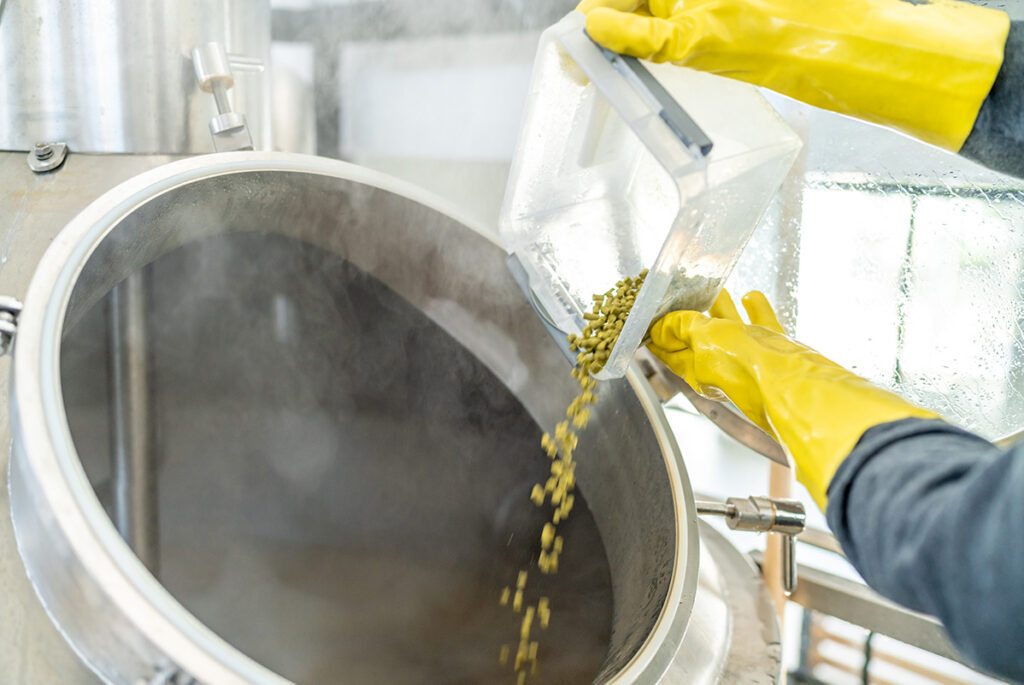
As a home brewer, you’re aware that hops play a vital role in your beer’s flavour, aroma, and bitterness. So, why not experiment with different hop varieties, amounts, timings, and methods to create truly unique and personalised brews?
In this section, we’ll delve into some techniques for tweaking hop additions to achieve new and exciting effects in your beer.
Hop Bursting: Intense Flavour and Aroma
Hop bursting involves adding a significant amount of hops in the last 15 minutes of the boil.
This method produces a smooth bitterness and an intense flavour and aroma, as the hop oils aren’t boiled off. To make your beer’s hop profile really stand out, give hop bursting a try.
Hop Standing: Extracting More Oils Without Boiling
Another technique worth considering is hop standing, which involves adding hops after flameout and allowing them to steep in the hot wort for a period of time before chilling.
This process extracts more oils from the hops without boiling them off, resulting in a more pronounced flavour and aroma.
Double Dry Hopping: Layered Aromas
For beers with a complex hop aroma, consider double dry hopping. This technique involves adding two rounds of dry hops at separate times during fermentation or conditioning.
By doing so, you’ll layer various aromas, creating depth and complexity in your beer’s hop character.
Selecting the Right Hops: A Guide for Home Brewers
Understanding Your Beer Style and Hop Needs
Different beer styles require specific hop characteristics, such as bitterness level, flavour profile, and aroma intensity. For instance, a Bohemian Pilsner needs low to moderate bitterness, a spicy and herbal flavour, and a subtle aroma from noble hops. On the other hand, an India Pale Ale (IPA) demands high bitterness, a citrusy and fruity flavour, and a strong aroma from American hops.
Developing Your Hop Selection Framework
To select the right hops for a given beer style, consider factors like origin, category, alpha acid content, essential oil content, and flavour descriptors.
Here’s a simple framework to guide you:
- Hop Origin and Beer Style
Identify the origin of the beer style and choose hops that match or complement it. For example, for a German beer style, go for German or other European hops.
For an American beer style, select American or other New World hops.
- Hop Category and Purpose
Identify the hop category and pick hops that suit the beer style’s purpose. For a bittering hop, choose one with a high alpha acid percentage and low essential oil content.
For an aroma hop, opt for one with a low to moderate alpha acid percentage and an oil profile associated with good aroma.
- Flavour Descriptors
Identify the hop’s flavour descriptors and select hops that match or contrast the beer style’s flavour profile. For a citrusy and fruity flavour, choose hops with similar aromas.
For a spicy and herbal flavour, go for hops with those aromas.
Classic Hop Varieties for Specific Beer Styles
Here are some examples of common hop varieties that pair well with certain beer styles:
Saaz for Bohemian Pilsner
A noble hop with low alpha acid percentage (around 3-5%) and high essential oil content (especially humulene), giving it a delicate, floral, spicy, and herbal aroma.
Saaz is ideal for brewing classic European beer styles like Bohemian Pilsner.
Cascade for American Pale Ale
A citrusy and fruity hop with a low to moderate alpha acid percentage (around 4.5-8%) and an oil profile known for good aroma.
Cascade offers flavours and aromas of grapefruit, lemon, lime, and floral notes, making it perfect for modern craft beers like American Pale Ale.
Magnum for Imperial Stout
A bittering hop with a high alpha acid percentage (around 12-14%) and low essential oil content.
Magnum provides a strong and clean bitterness that balances the sweetness and roastiness of the malt, making it ideal for high gravity beers like Imperial Stout.
The Future of Hops: Current Research and Developments
Exciting New Varieties on the Horizon
There are some incredibly exciting new hop varieties being developed and discovered by researchers and breeders worldwide.
Here are just a few that you might want to keep an eye out for:
- Talus: This descendant of Sabro boasts intense aromas of pink grapefruit, citrus rinds, dried roses, pine resin, tropical fruits, and sage. With its high oil content and unique neomexicanus heritage, Talus offers a fantastic blend of characteristics.
- Eclipse: Hailing from Australia, Eclipse has a high alpha acid content and imparts flavours of mandarin, citrus peel, pine, and sweet tropical fruits. Its high yield potential and balanced bitterness make it an attractive option for brewers.
- Nectaron: This New Zealand variety has a high oil content and offers flavours of passionfruit, pineapple, grapefruit, and stone fruit. What sets Nectaron apart is its high resistance to powdery mildew and its distinctive tropical fruit flavour.
- Solero: A German variety with a complex flavour profile, Solero includes notes of lemon, lime, orange, passionfruit, and peach. Its high tolerance for drought and heat stress, combined with a versatile flavour profile, make it suitable for various beer styles.
- Elixir: This French variety of hops has a floral and fruity aroma with a spicy and herbal flavour. Elixir also boasts high resistance to downy mildew and aphids, making it a dual-purpose hop for bitterness and aroma.
- Harlequin: A British variety with a high alpha acid content and a citrus and tropical fruit aroma. Harlequin is highly resistant to wilt and verticillium and has a strong aroma impact, making it ideal for dry hopping.
These new hop varieties have already made their way into some beers, such as:
- Talus: Sierra Nevada Torpedo Extra IPA, Firestone Walker Luponic Distortion IPA No. 16, New Belgium Voodoo Ranger IPA
- Eclipse: Coopers XPA, Hop Nation Jedi Juice NEIPA, Balter Hazy IPA
- Nectaron: Garage Project Party & Bullshit Hazy IPA, Behemoth Lid Ripper Hazy IPA, Epic Hopshine Pale Ale
- Solero: Riegele Brauhaus Solero Pale Ale, Maisel & Friends Solero IPA, BRLO German IPA
- Elixir: Brasserie de la Goutte d’Or Elixir IPA, Brasserie du Mont Salève Elixir Pale Ale, Brasserie de la Pleine Lune Elixir Blonde
- Harlequin: Charles Faram Hop Development Programme Harlequin Pale Ale, Wye Valley Brewery Harlequin Golden Ale, Tiny Rebel Brewing Co. Harlequin IPA
Advances in Hop Processing and Usage
Innovations and improvements in hop processing techniques are making it possible for brewers like us to get even more out of our hops. Here are some of the latest advancements in the field:
- Pelletizing: This process compresses hop cones into small pellets, about 6-10 millimetres (1/4 to 3/8 inch) in diameter, making them easier to store, transport, and use than whole leaf hops. The reduced oxygen exposure and moisture content of pelletized hops help preserve their freshness and potency for longer periods.
- Cryo-hopping: By separating hop lupulin glands from vegetative matter using liquid nitrogen, concentrated hop pellets or powder can be created. These cryo-hops have higher alpha acid and oil content than regular pellets, increasing their efficiency and intensity for bittering, flavouring, and aroma applications.
- CO2 extraction: This technique extracts hop resins and oils from hop cones using pressurized carbon dioxide, resulting in a more stable and consistent hop extract. This reduces the variability and degradation of hop components due to heat or light exposure.
Buy Hops
Here at The Yeast Platform we sell the highest quality pellet hops. You can view our available range at our store here.

